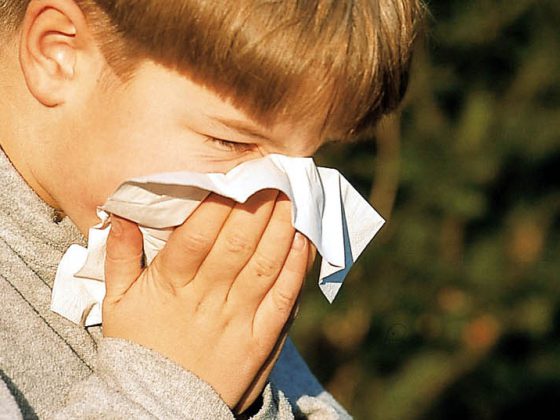Worldwide, around 53 million people die of tuberculosis, HIV and malaria within a year. The inhabitants of tropical and poor countries are particularly affected. But even the rich Switzerland is not an island, the people are too eager to travel and adventurous for that.
The 52nd Lunge Zurich Davos Medical Education Course again attracted over 600 physicians, residents and speakers. The program committee around the course director Prof. Dr. med. Erich W. Russi, Zurich, consisting of Dr. med. Franziska Morger, Zurich, Prof. Dr. med. Thomas Rosemann, Zurich, and Dr. med. Alexander Turk, Wald, this year also organized three lectures on the most important infectious diseases worldwide. The experts elaborated on what of this is significant for Swiss physicians.
A warning up front to long-distance travelers and their doctors: medications purchased abroad are often counterfeits. If therapy is needed after returning home, it should definitely be done with domestic quality products. This was pointed out by the tropical medicine specialist Prof. Christoph Hatz, Zurich, MD. “Sudden high fever with chills in tropical returnees should be taken very seriously,” he warned, “even a few parasites can become life-threatening for them.” Tuberculosis and HIV are explosive among at-risk persons (immigrants, persons with sexual risk behavior), and the tropical diseases malaria and dengue fever are always an issue among long-distance travelers.
AIDS – where are we today?
In Switzerland, up to 600 new HIV infections are still reported each year, and AIDS is still not curable. The Swiss HIV cohort has been maintained since 1988 and provides important data on an ongoing basis. “Many HIV studies are Swiss made,” elaborated Prof. Rainer Weber, MD, of the Clinic for Infectious Diseases and Hospital Hygiene in Zurich. In the medical field, post-exposure prophylaxis (PEP) is always a necessity when coming into contact with blood from an HIV-positive person, he said. HIV PEP should be initiated as soon as possible after a possible exposure, even before the virus can settle in human cells. Taking a three-drug combination for four weeks is an effective and safe antiviral therapy, he said. PEP is also an option after a dangerous sexual contact, he said, if the triple combination is started within 48 hours of contact. It is not necessary, as has been shown in Switzerland in the HIV cohort, if the viral load in the HIV-positive partner is below the detection limit due to antiretroviral therapy. However, the condom is still essential for prevention during sexual contact with a person whose HIV status is unknown.
A rapid test (sensitivity poor in acute infection) and the combo test (combined antibody-antigen test, gold standard) are available for HIV diagnosis. Viral replication is so well understood in detail, he said, that drug interruption can now be performed at five sites. “There should always be a combination of two different mechanisms,” Prof. Weber elaborated. Where exactly and in what combination is a matter for experts. Therapeutic failure is no longer a drama, he said; one can almost always offer other options. In Zurich, family physicians who specialize in HIV patients were able to achieve equally good results as the USZ, Prof. Weber further reported.
Current studies with blocking antibodies are also encouraging; it is hoped to be able to create a cocktail that definitively binds HIV. Gene therapy is still in experimental mode due to rapid changes in viruses presenting different antigens. That bone marrow transplantation may keep HIV in check can only be considered proof of principles. “So far, there is only one case in the world where a patient is considered cured of HIV,” Prof. Weber led. A virus reservoir in the lymphatic tissue will probably always remain, and eradication is not yet possible.
Globally, HIV treatment is provided according to the capabilities of the country and what can be afforded or as the side effect profile dictates. A big step forward are the new combination products and formulations. Whereas in the past a handful of pills per intake was necessary, today three pills per day can suffice.

TB in Switzerland
Every year, almost nine million people worldwide contract tuberculosis (TB); of these, approximately 1.5 million die from the disease. Falling numbers in this country do not mean that TB does not continue to claim numerous victims elsewhere and represent a ticking time bomb. This was stated by Prof. Dr. med. Hans L. Rieder, Kirchlindach, of the International Union Against Tuberculosis and Lung Disease. “Few diseases make it as clear as tuberculosis how closely poverty and disease are linked,” he said in Davos. Thus, TB has become a rare disease in affluent Switzerland: Fewer than ten people per 100,000 inhabitants contract the disease each year, and virtually no one dies from it. This represents a hundredfold decrease in deaths. The risk of contracting TB in Switzerland is almost zero.
But like HIV and other STIs, TB remains present among at-risk groups. In Switzerland, it mostly affects older people and immigrants. The correlation between birth cohort and age of onset is interesting: adolescents and children of the present age in Switzerland have a reduced risk of 1:100,000. At the time of the Davos Magic Mountain, TB had a lethality of 80%. The introduction of curative chemotherapy with streptomycin, para-aminosalicylic acid, and isoniazid meant that TB today is not necessarily fatal – at least not in our latitudes.
Prof. Rieder listed five points that are still given too little attention when considering tuberculosis as the conclusion to his remarks:
- The role of growing prosperity should not be underestimated.
- Nothing in tuberculosis happens overnight, but…
- …the introduction of chemotherapy has completely changed the impact of tuberculosis.
- Industrialization, HIV, migration flows influence events.
- The affordability of interventions for the poorest countries remains a fundamental problem.
One million malaria deaths
“Despite great progress, it is estimated that around one million people will continue to die from malaria in 2013. Of the six pathogens known so far, Plasmodium falciparum is still the most dangerous,” Prof. Hatz explained. Great hopes are pinned on a rapid diagnostic test (RDT), which allows a more reliable diagnosis than the microscopic search for plasmodia. This can limit false positive findings, according to the prognosis. This is all the more important, he said, because studies have shown that in some countries the guiding principle “fever = malaria” applies and a lot of money is spent on unnecessary therapies based on an incorrect diagnosis. Furthermore, counterfeit medicines, which often contain no or only insufficient quantities of active ingredients, must not be given a chance, and the private sector should be involved in health care, according to important demands.
In principle, sufficient and good-quality artemisinin combination preparations are available for the treatment of malaria. Three effective chemoprophylactics, very efficient repellents and insecticide-prepared mosquito nets provide such effective protection that malaria is diagnosed less and less frequently in long-distance tourists returning to Switzerland. We can also be proud of the fact that for some time now there have been no malaria deaths due to delayed diagnosis by Swiss doctors.
“Our efforts to develop a vaccine have unfortunately not yet been so crowned with success. So far, at least, vaccination protection of about 30-50% is achieved in various groups of the population in malaria areas,” Prof. Hatz regretted.
A second tropical disease that is spreading worldwide and getting closer (Croatia, France, Madeira) is dengue fever, a mosquito-borne viral disease. The only therapy is paracetamol (no ASA!). Prophylaxis with repellents and impregnated clothing is particularly useful in tropical megacities, the tropical physician recommended.
Source: 52nd Lung Zurich Continuing Medical Education Course, January 10-12, 2013, Davos.
Literature:
- World Malaria Report, 2012 cdc.gov/who.int; Murray, 2012.
- Global Burden of Disease 2010. The Lancet 2012; 380: 2063-2066.











